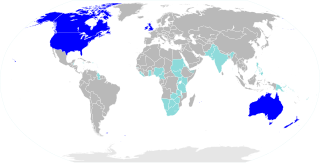ଇଂରାଜୀ ଭାଷା
ପଶ୍ଚିମ ଜର୍ମାନୀୟ ଭାଷା
ଇଂରାଜୀ ଭାଷା ଏକ ପଶ୍ଚିମ ଜର୍ମାନୀୟ ଭାଷା । ଏହା ଇଂଲ୍ୟାଣ୍ଡ୍ ଆରମ୍ଭ ହୋଇ ବର୍ତ୍ତମାନ ସାରା ବିଶ୍ୱରେ ବହୁଳ ମାତ୍ରାରେ ବ୍ୟବହାର ହେଉଛି ।[୪] ଏହା ଯୁକ୍ତରାଜ୍ୟ, ଯୁକ୍ତରାଷ୍ଟ୍ର ଆମେରିକା, କ୍ୟାନାଡା, ଅସ୍ଟ୍ରେଲିଆ, ଆୟର୍ଲ୍ୟାଣ୍ଡ୍, ନିଉଜିଲ୍ୟାଣ୍ଡ୍ ଓ ଅନେକ କ୍ୟାରିବିଆନ୍ ରାଷ୍ଟ୍ର ସମେତ ଆହୁରି ଅନେକ ରାଷ୍ଟ୍ରରେ ପ୍ରଥମ ଭାଷା ରୂପେ ବ୍ୟବହାର କରାଯାଇଥାଏ ।
| ଇଂରାଜୀ | |
|---|---|
| ଉଚ୍ଚାରଣ | /ˈɪŋɡlɪʃ/[୧] |
| ଅଞ୍ଚଳ | (see below) |
ମାତୃଭାଷୀ | ପ୍ରକାଶନରେ ଅସୁବିଧା: ଅଜଣା ଚିହ୍ନ "୨" ।[୨] L2: ≈ 250 million (2001)[୨] to ≈ 1.8 billion (2004)[୩] |
Indo-European
| |
| English alphabet (Latin script) | |
| ଆଧିକାରିକ ସ୍ଥିତି | |
କେଉଁଠି ରାଜଭାଷା: | 54 countries 27 non-sovereign entities United Nations European Union Commonwealth of Nations Council of Europe IOC NATO NAFTA OAS OECD OIC PIF UKUSA Agreement |
| ଭାଷା କୋଡ୍ | |
| ISO ୬୩୯-୧ | en |
| ISO ୬୩୯-୨ | eng |
| ISO ୬୩୯-୩ | eng |
| Linguasphere | 52-ABA |
 Countries where English is an official or de facto official language, or national language, and is spoken fluently by the majority of the population Countries where it is an official but not primary language | |
ବିଶେଷତ୍ୱ
ଇତିହାସ
ବିଭକ୍ତିକରଣ
ଭୋଗୋଳିକ ବଣ୍ଟନ
ବ୍ୟବହାରକାରୀ ରାଷ୍ଟ୍ର
| Country | Total | Percent of population | First language | As an additional language | Population | Comment | |
|---|---|---|---|---|---|---|---|
 ଯୁକ୍ତରାଷ୍ଟ୍ର ଆମେରିକା ଯୁକ୍ତରାଷ୍ଟ୍ର ଆମେରିକା | ୨୫୧,୩୮୮,୩୦୧ | ୯୬% | ୨୧୫,୪୨୩,୫୫୭ | ୩୫,୯୬୪,୭୪୪ | ୨୬୨,୩୭୫,୧୫୨ | Source: US Census 2000: Language Use and English-Speaking Ability: 2000, Table 1. Figure for second language speakers are respondents who reported they do not speak English at home but know it "very well" or "well". Note: figures are for population age 5 and older | |
 ଭାରତ ଭାରତ | ୧୨୫,୩୪୪,୭୩୫ | ୧୨% | ୨୨୬,୪୪୯ | ୮୬,୧୨୫,୨୨୧ second language speakers. ୩୮,୯୯୩,୦୬୬ third language speakers | ୧,୦୨୮,୭୩୭,୪୩୬ | Figures include both those who speak English as a second language and those who speak it as a third language. 2001 figures.[୫][୬] The figures include English speakers, but not English users.[୭] | |
 ପାକିସ୍ତାନ ପାକିସ୍ତାନ | ୮୮,୬୯୦,୦୦୦ | ୪୯% | ୮୮,୬୯୦,୦୦୦ | ୧୮୦,୪୪୦,୦୦୫ | Source: Euromonitor International report 2009. "The Benefits of the English Language for Individuals and Societies: Quantitative Indicators from Cameroon,Nigeria, Rwanda, Bangladesh and Pakistan." 'A custom report compiled by Euromonitor International for the British Council'. | ||
| ନାଇଜେରିଆ | ୭୯,୦୦୦,୦୦୦ | ୫୩% | ୪,୦୦୦,୦୦୦ | >୭୫,୦୦୦,୦୦୦ | ୧୪୮,୦୦୦,୦୦୦ | Figures are for speakers of Nigerian Pidgin, an English-based pidgin or creole. Ihemere gives a range of roughly 3 to 5 million native speakers; the midpoint of the range is used in the table. Ihemere, Kelechukwu Uchechukwu. 2006. "A Basic Description and Analytic Treatment of Noun Clauses in Nigerian Pidgin. Archived 2007-06-10 at the Wayback Machine." Nordic Journal of African Studies 15(3): 296–313. | |
 ଯୁକ୍ତରାଜ୍ୟ ଯୁକ୍ତରାଜ୍ୟ | ୫୯,୬୦୦,୦୦୦ | ୯୮% | ୫୮,୧୦୦,୦୦୦ | ୧,୫୦୦,୦୦୦ | ୬୦,୦୦୦,୦୦୦ | Source: Crystal (2005), p. 109. | |
 ଫିଲିପାଇନ୍ସ ଫିଲିପାଇନ୍ସ | ୪୮,୮୦୦,୦୦୦ | ୫୮%[୮] | ୩,୪୨୭,୦୦୦[୮] | ୪୩,୯୭୪,୦୦୦ | ୮୪,୫୬୬,୦୦୦ | Total speakers: Census 2000, text above Figure 7. 63.71% of the 66.7 million people aged 5 years or more could speak English. Native speakers: Census 1995, as quoted by Andrew González in The Language Planning Situation in the Philippines, Journal of Multilingual and Multicultural Development, 19 (5&6), 487–525. (1998). Ethnologue lists 3.4 million native speakers with 52% of the population speaking it as an additional language.[୮] | |
 କାନାଡ଼ା କାନାଡ଼ା | ୨୫,୨୪୬,୨୨୦ | ୮୫% | ୧୭,୬୯୪,୮୩୦ | ୭,୫୫୧,୩୯୦ | ୨୯,୬୩୯,୦୩୦ | Source: 2001 Census – Knowledge of Official Languages Archived 2018-10-16 at the Wayback Machine. and Mother Tongue Archived 2018-10-16 at the Wayback Machine.. The native speakers figure comprises 122,660 people with both French and English as a mother tongue, plus 17,572,170 people with English and not French as a mother tongue. | |
 ଅଷ୍ଟ୍ରେଲିଆ ଅଷ୍ଟ୍ରେଲିଆ | ୧୮,୧୭୨,୯୮୯ | ୯୨% | ୧୫,୫୮୧,୩୨୯ | ୨,୫୯୧,୬୬୦ | ୧୯,୮୫୫,୨୮୮ | Source: 2006 Census.[୯] The figure shown in the first language English speakers column is actually the number of Australian residents who speak only English at home. The additional language column shows the number of other residents who claim to speak English "well" or "very well". Another 5% of residents did not state their home language or English proficiency. | |
| ନ୍ୟୁଜିଲାଣ୍ଡ | ୩,୬୭୩,୬୨୬ | ୯୧.୨% | ୩,୦୦୮,୦୫୮ | ୬୬୫,୫୬୮ | ୪,୦୨୭,୯୪୭ | Source: 2006 Census.[୧୦] The figures are people who can speak English with sufficient fluency to hold an everyday conversation. The figure shown in the first language English speakers column is actually the number of New Zealand residents who reported to speak English only, while the additional language column shows the number of New Zealand residents who reported to speak English as one of two or more languages. | |
| Note: Total = First language + Other language; Percentage = Total / Population | |||||||
ଅଧିକ ଦେଖନ୍ତୁ
ଆଧାର
ଅଧିକ ତଥ୍ୟ

Appendix:List of Proto-Indo-European roots ଶବ୍ଦଟି ଉଇକି ଅଭିଧାନରେ ଖୋଜନ୍ତୁ ।

Wikiversity has learning materials about Topic:English Language

ଉଇକି କଥାରେ ଇଂରାଜୀ ଭାଷା ସମ୍ବନ୍ଧୀୟ ଅନେକ ଲୋକବାଣୀ ରହିଛି

English ଶବ୍ଦଟି ଉଇକି ଅଭିଧାନରେ ଖୋଜନ୍ତୁ ।
 ଉଇକିମିଡ଼ିଆ କମନ୍ସରେ English language-ସମ୍ପର୍କିତ ମିଡ଼ିଆ
ଉଇକିମିଡ଼ିଆ କମନ୍ସରେ English language-ସମ୍ପର୍କିତ ମିଡ଼ିଆ- Accents of English from Around the World (University of Edinburgh) Hear and compare how the same 110 words are pronounced in 50 English accents from around the world – instantaneous playback online
- Dictionaries
🔥 Top keywords: ପ୍ରଧାନ ପୃଷ୍ଠାରାମ ନବମୀଓଡ଼ିଆ ଭାଷାବିଶେଷ:ଖୋଜନ୍ତୁସୁଦଶା ବ୍ରତମିଡ଼ିଆଉଇକି:Interwiki-links.jsଜଗନ୍ନାଥ ଦାସଅମୃତାୟନଉଇକିପିଡ଼ିଆ:ଉଇକିପିଡ଼ିଆ ବାବଦରେଦ୍ୱିତୀୟ ବିଶ୍ୱଯୁଦ୍ଧଉଇକିପିଡ଼ିଆ:ସଙ୍ଘ ସୂଚନା ଫଳକବିଜୁ ପଟ୍ଟନାୟକରାଧାନାଥ ରାୟଜଗନ୍ନାଥ ମନ୍ଦିରରାମଫକୀର ମୋହନ ସେନାପତିସହଯୋଗ:ବିଷୟବସ୍ତୁଜଗନ୍ନାଥଉଇକିପିଡ଼ିଆ:ଆମ ସହ ଯୋଗାଯୋଗରାମାୟଣଓଡ଼ିଆ ସାହିତ୍ୟସାରଳା ଦାସମଧୁସୂଦନ ଦାସଉଇକିପିଡ଼ିଆଗୋପବନ୍ଧୁ ଦାସଗଙ୍ଗାଧର ମେହେରwiki.phtmlଗୋପୀନାଥ ମହାନ୍ତିଲିଙ୍ଗରାଜ ମନ୍ଦିରଗୋଦାବରୀଶ ମିଶ୍ରମଧୁସୂଦନ ରାଓଉଇକିପିଡ଼ିଆ:ଆମେ ଦାୟୀ ନୋହୁଁନମିତା ଅଗ୍ରୱାଲଶାନ୍ତନୁ କୁମାର ଆଚାର୍ଯ୍ୟଛାଞ୍ଚ:Key press/docପଣା ସଂକ୍ରାନ୍ତିଲକ୍ଷ୍ମୀକାନ୍ତ ମହାପାତ୍ରମନୋଜ ଦାସଅଂଶୁଘାତ
